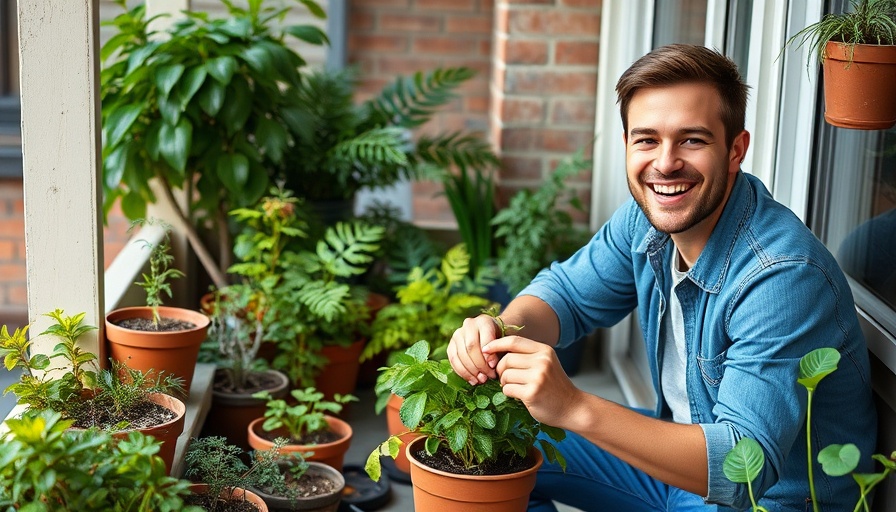
Transforming Small Spaces into Beautiful Gardens
The dream of every homeowner is to have a lush garden that becomes their personal oasis. But for those with limited space, achieving that dream may seem daunting. Luckily, with some creativity and the right approach, even the tiniest yard can be transformed into a vibrant garden. As discussed in the video Transform Any Small Space Into A Vibrant Garden!, this transformation begins with understanding how to cleverly utilize potted plants to create height, interest, and a striking aesthetic.
In Transform Any Small Space Into A Vibrant Garden!, the discussion dives into innovative garden design techniques, exploring key insights that sparked deeper analysis on our end.
Exploring the Benefits of Container Gardening
Container gardening is an excellent solution for small spaces, offering numerous benefits. First and foremost, it allows for flexibility and creativity. Various types of pots can elevate your garden design, adding layers and texture. In the video, the use of seafoam pots gives the garden a unique edge, illustrating how even simple choices can have a big impact on visual appeal.
When selecting plants for containers, as shown, it’s crucial to consider their growth habits and water requirements. Mixing plants that have similar watering needs can help maintain healthy growth. The Magnolia Sulangana, a small tree suitable for pots, not only provides shade during the summer but also lets light in during winter, showcasing a thoughtful blend of utility and beauty.
Creating a Cohesive Garden Design
Another essential aspect of garden design is ensuring a cohesive look that blends well with the overall aesthetics of your home and garden. This includes considering colors, shapes, and sizes of plants and containers. The video emphasizes the importance of using a good quality potting mix that promotes soil health. For instance, products with slow-release fertilizers and fillers can enhance the growth of flowering plants, boosting the health of your greenery and improving overall garden maintenance.
Integrating Vertical Gardening Techniques
Height can significantly alter the perception of space, and in smaller gardens, vertical gardening can be a game-changer. By implementing trellises or hanging pots, gardeners can maximize their limited area without overcrowding. The incorporation of vertical elements not only optimizes space but also produces vibrant displays of flowers and foliage. As suggested, pots can serve multiple purposes, from ornamental to functional aspects, lending to the garden's overall appeal and functionality.
Importance of Mulching and Soil Health
After establishing a design and planting, mulching becomes crucial. Mulching not only conserves moisture in the soil but also suppresses weeds while adding visual coherence to the overall design. As highlighted in the video, using decorative pebbles can provide a lovely contrast against the lush foliage while maintaining the benefits of organic material decomposition.
Additionally, keeping your soil healthy through regular fertilizing and well-planned watering schedules lays the foundation for a thriving garden. Remember, healthy soil leads to healthy plants, and an effective irrigation system can streamline this process, especially in smaller spaces where every drop counts.
Future Trends in Garden Design: Embracing Edible Gardens
As urban gardening becomes more popular, integrating edible plants into your garden design can offer both aesthetic and practical benefits. Combining perennial flowers with herbs and vegetables creates a beautiful and functional space. Homeowners should consider edible flowers, such as nasturtiums, which can add color and flavor to your dishes while enhancing garden beauty.
Moreover, community gardens are popping up in urban areas, encouraging neighbors to come together and share gardening tips. These edible gardens foster a sense of community, reflecting sustainable gardening practices that can benefit the environment and enhance neighborhood bonds.
Conclusion: Your Garden Awaits!
Transforming your small yard into a vibrant garden is an achievable goal. With the right tools and techniques—like container gardening, vertical elements, and selecting ideal plants—homeowners can create lasting beauty right outside their doors. As the video Transform Any Small Space Into A Vibrant Garden! showcases, a little creativity goes a long way. Don't be afraid to experiment and let the beauty of your garden shine!
 Add Row
Add Row  Add
Add 




Write A Comment